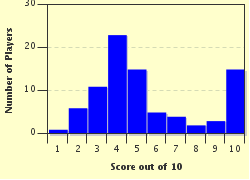Quiz Answer Key and Fun Facts
1. 'Collection of Miscellanea at Duyang' is the first known reference to playing cards and card games. 'Yezi Gexi' was the first known book about cards and card games. They were both written in the Tang era of which ancient civilization?
2. Ancient Chinese 'money cards' had four 'suits' although these were not the 'standard' hearts, diamonds, clubs, spades. What picture was used to represent each particular 'suit'?
3. It is believed that the first deck of cards ever printed was represented by each of the 21 combinations of a pair of dice. What was this deck called?
4. The widespread use of playing cards in Europe can be traced back to about 1377, with evidence of use and restrictions prior to this date. The Mameluke deck has suits similar to the tarot, yet contained 52 cards with the ten 'spot' cards and three 'court' cards similar to that we see today. Listed below are the names of those court cards, all except one. Which was NOT a court card?
5. Some early cards were printed using a woodcut technique (using a carved block of wood covered in ink then pressed onto paper). From about the early to mid-1400s one artist, known as the 'Master of Playing Cards', created cards using which newly invented printmaking technique?
6. Modern cards have the suits: hearts, diamonds, spades and clubs (although this isn't always the case). These suits originated in the late 1400s in which European country?
7. The court card modern standard became 'King of Spades', 'Queen of Hearts', 'Knave of Diamonds', etc. Each of these court cards has a traditional Parisian name and whilst the 'King' names are quite well known, the 'Queen' and 'Knave' are not. Of the following listed, which is NOT one of the traditional Parisian 'Queen' card names?
8. Which French eighteenth century innovation was part of a major design change for court cards, making it harder for players to tell which cards their opponent was holding?
9. Jokers were introduced to the modern card deck in the late nineteenth century by the United States. They were introduced to join the 'Jack' (formerly 'Knave') cards as a bower (bauer) for which popular card game?
10. A standard 56-card deck of cards has an extra court card (compared with the standard 52-card deck). The King, Queen and Jack are there but what is the designation of the fourth court card?
Source: Author
lones78
This quiz was reviewed by FunTrivia editor
bloomsby before going online.
Any errors found in FunTrivia content are routinely corrected through our feedback system.

